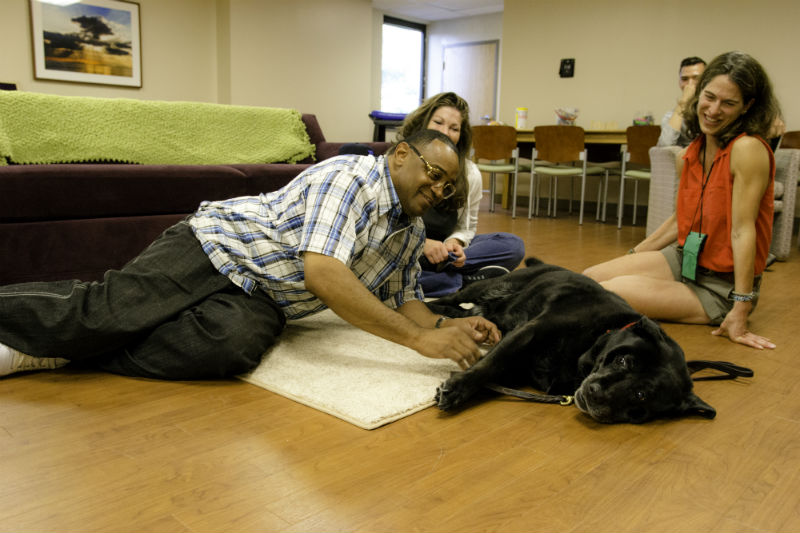No one experiences anxiety the same way as someone else. Understanding the signs, symptoms and side effects of anxiety is a key component toward starting the recovery journey.
Understanding Anxiety
Learn about anxiety
Anxiety, when experienced at a level that is not overtly distressing, can be healthy for some people. It can increase a person’s alertness when danger or harm is possible or can be fun when an individual is about to do something exciting. However, many people experience a kind of anxiety that has devastating effects on their daily functioning. When this kind of anxiety is present and causes prolonged feelings of worry, apprehension, and/or fear, mundane tasks, like making a phone call or driving a car, can seem impossible.
Anxiety disorders can present differently in others as triggers for anxiety can vary and lead to the onset of different symptoms. For example, obsessive-compulsive disorder can be triggered by post-traumatic stress disorder if an individual experiences, witnesses, or learns about a traumatic event. This kind of anxiety can lead to ongoing ritualistic behaviors and thoughts of impending doom throughout the day. Specific phobias can trigger anxious feelings and cause a person to avoid specific people, places, or things. Other examples of anxiety disorders include generalized anxiety disorder, panic disorder, social anxiety disorder, and agoraphobia.
Depending on the type of anxiety disorder is present, methods of treatment for these conditions can vary. What is important to know, however, is that treatment is available and can be extremely helpful in reducing or eliminating pervasive feelings of uneasiness, trepidation, and/or dread. Effective care for these conditions can restore healthy functioning by teaching appropriate coping skills that can reduce the possibility of anxiety wreaking further havoc on a person’s life.
Statistics
Anxiety statistics
Anxiety disorders have the capacity to affect adults and children alike. According to the Anxiety and Depression Association of America, 40 million adults meet diagnostic criteria for an anxiety disorder or disorders. Additionally, it has been estimated that nearly 2 million children also suffer from anxiety, including specific phobias.
Causes and Risk Factors
Causes and risk factors for anxiety
Experts on anxiety disorders believe that a number of contributing factors can lead to the development of anxiety symptoms in a person. These factors include:
Genetic: Mental health professionals have concluded that anxiety disorders have strong genetic ties. Those that have a first-degree relative with an anxiety disorder have an increased risk of showing signs and symptoms at some point in his or her lifetime.
Physical: Chemical imbalances in the brain are believed to cause anxiety symptoms to manifest in a person. Certain neurotransmitters that are responsible for an individual’s fight or flight response are known to be greatly affected when a person experiences anxiety. This effect impacts a person’s ability to cope and, when these chemicals are not balanced, unhealthy responses to stress can become apparent.
Environmental: Environmental stressors are known to contribute to the development of anxiety disorders. Stress in one’s home, at school, or work can elevate anxious feelings and lead to the onset of an anxiety disorder. Furthermore, experiencing trauma or exposure to chaos can also make a person more susceptible to developing anxiety symptoms and is especially true for those who do not have healthy coping skills for managing stress.
Risk Factors:
- Family history of anxiety or other mental health conditions
- Personal history of mental illness
- Experiencing chronic stress or trauma
- Being exposed to stressful environments
Signs and Symptoms
Signs and symptoms of anxiety
Depending on the type of anxiety a person is experiencing, the signs and symptoms present can be different because certain symptoms are specific to certain anxiety disorders. The array of symptoms that infer the presence of an anxiety disorder include:
Behavioral symptoms:
- Inability or refusal to fulfill roles / responsibilities
- Isolation from friends and loved ones
- Easily triggered startle response
- Pacing
- Procrastination
- Avoidance of certain people, places, or things
- Restlessness
- Jitteriness
- Employing ritualistic behaviors
- Difficulty communicating effectively
Physical symptoms:
- Headaches
- Stomachaches
- Labored breath
- Profuse sweating
- Broken sleep patterns
- Disordered eating
- Increased heart rate
- Elevated blood pressure
- Frequent urination
- Muscle tension
- Dizziness
Cognitive symptoms:
- Problems with concentration
- Poor decision-making
- Racing thoughts
- Fleeting ideas
- Ritualistic thinking
- Obtrusive compulsions
Psychosocial symptoms:
- Depersonalization
- Extreme shifts in mood
- Overwhelming feelings of guilt
- Nervous feelings
Effects
Effects of anxiety
Untreated anxiety can render a number of devastating effects on a person’s functioning and life. Listed are the effects that could occur:
- Drug and/or alcohol abuse
- Social withdrawal / isolation
- Decline in quantity and quality of interpersonal relationships
- Academic failure
- Loss of employment
- Self-harm
- Suicidal thoughts
- Attempts at taking one’s own life
Co-Occurring Disorders
Anxiety and co-occurring disorders
Anxiety disorders are often diagnosed in addition to other mental health conditions. Sometimes occurring in response to anxiety symptoms or, conversely, anxiety occurs following symptoms of another disorder, the following mental illnesses can be present when a person is suffering from an anxiety disorder:
- Specific phobias
- Agoraphobia
- Panic disorder
- Obsessive-compulsive disorder
- Attention-deficit/hyperactivity disorder
- Depressive disorders
- Bipolar disorder
- Post-traumatic stress disorder
- Eating disorders
- Schizoaffective disorder
- Schizophrenia
- Personality disorders
- Substance use disorders









